2018北外英语翻译基础真题回忆版
北外翻译专业考研试题及答案

北外翻译专业考研试题及答案试题:北外翻译专业考研模拟试题一、词汇翻译(每题2分,共20分)1. 请将下列中文词汇翻译成英文:- 创新- 可持续发展- 人工智能- 国际贸易- 文化多样性2. 请将下列英文词汇翻译成中文:- Globalization- E-commerce- Biodiversity- Climate change- Human rights二、句子翻译(每题5分,共30分)3. 将下列中文句子翻译成英文:- 随着科技的不断进步,我们的生活变得越来越便捷。
- 教育是提升一个国家整体素质的关键。
- 保护环境是每个公民的责任。
4. 将下列英文句子翻译成中文:- "Knowledge is power" is a well-known proverb that encourages continuous learning.- The rapid development of technology has brought about significant changes in our daily lives.- Environmental protection should be a priority for governments worldwide.三、段落翻译(每题25分,共50分)5. 将下列中文段落翻译成英文:随着全球化的深入发展,跨国公司在世界经济中扮演着越来越重要的角色。
它们不仅推动了国际贸易的增长,还促进了文化交流和技术创新。
6. 将下列英文段落翻译成中文:In the face of climate change, it is imperative that we take immediate action. Sustainable practices must be adopted to reduce our carbon footprint, and international cooperation is essential to address this global challenge.答案:一、词汇翻译1. 创新 - Innovation可持续发展 - Sustainable development人工智能 - Artificial intelligence国际贸易 - International trade文化多样性 - Cultural diversity2. 全球化 - Globalization电子商务 - E-commerce生物多样性 - Biodiversity气候变化 - Climate change人权 - Human rights二、句子翻译3. 随着科技的不断进步,我们的生活变得越来越便捷。
北外英语学院翻译考研真题

北外英语学院翻译考研真题一、英译汉Passage 1:The Price of EducationThe fact that university education has become such a lucrative business has attracted much attention. Universities in the United States, for example, constantly compete to attract students, and they do so by offering various inducements.Some universities offer better facilities, and try to create an attractive environment in which to live and study. Increasingly, however, the quality of education is also being judged by the percentage of graduates who are able to find employment after graduation. Employers, it seems, are no longer satisfied with a university education per se, but want to be assured that graduates will have the skills necessary for the job. To ensure this, some universities are offering simulated work experience as part of their degree programs. Some universities even venture into the realm of industry and commerce, regarding themselves as training colleges rather than as scholarly institutions.The motives behind this new emphasis on practical training are not entirely altruistic. Many universities in the United Kingdom, for example, rely heavily on government funding. The thinking is that by producing employable graduates, universities are not only ensuring that their graduates get good jobs and earn good money, they are also reducing the burden on thestate. Indeed, in some countries, universities that fail to achieve high levels of graduate employment are actually penalized financially.But what is sacrificed in this obsession with practicality? The traditional concept of a university is based on the belief that knowledge is valuable in itself, and that the purpose of education is the pursuit of truth. To surrender this belief and degrade the university to the role of industry training center is to throw the baby out with the bathwater. Certainly, graduates must be able to find employment to support themselves, but a society that puts material gain above all else is a society that has lost its soul.Passage 2:Another Look at Cross-cultural CommunicationThe common expectation of much cross-cultural training is that it is designed to help business people improve their cross-cultural communication competence, thus increasing performance in a variety of multicultural or international contexts. Cross-cultural training often takes the form of brief seminars, sometimes with hands-on experiential exercises and is meant to be enjoyable, eye-opening and informative. Many authors believe that by offering such training, organizations are doing the right thing for their employees because effective cross-cultural communication skills can be a competitive advantage in business.However, less attention has been given to understanding the linkage between the skills and competencies that have been delineated and measured and the ability of learners to effectively apply such knowledge and abilities in specific situations they are likely to encounter at work. Despite the proliferation of studies advocating the use of cross-cultural training toenhance global management effectiveness, very little is known about how training may affect the actual performance of individuals or groups that are experiencing business or mission/aid-related challenges outside of their native cultural contexts.In today’s globalized and technological world, businesses and individuals are more connected across cultural boundaries than ever. In fact, almost all businesses from small to multinational employ individuals who have some form of cross-cultural interactions on a daily basis. By increasing our understanding of the linkages between knowledge, skills and abilitiesand desired training outcomes, we may be able to help individuals and organizations more effectively navigate the challenges associated with increasingly dynamic and complex cross-cultural task environment in which they operate.二、汉译英翻译 Passage 1:教育的代价大学教育已成为一个利润丰厚的生意,这一事实引起了广泛关注。
[考研类试卷]2014年北京外国语大学英语翻译基础真题试卷.doc
![[考研类试卷]2014年北京外国语大学英语翻译基础真题试卷.doc](https://img.taocdn.com/s3/m/966e468976c66137ef061926.png)
[考研类试卷]2014年北京外国语大学英语翻译基础真题试卷英译汉1 UNDP2 OECD countries3 bailout loans4 EBITA5 venture capital6 telepresence7 carbon footprint8 forensic medicine9 key encryption technology10 United Arab Emirates11 extradition treaty12 seismic monitoring13 procrastination14 flip phone15 Mack Daddy汉译英16 大部制17 石油输出国组织18 生物圈19 涨停板20 浮动汇率21 计划免疫22 学生减负23 通识教育24 B超25 自媒体26 土地承载能力27 小产权房28 土豪29 胶原蛋白30 经济适用男英译汉31 Never before had the world such a tremendous scientific-technical potential, such a capacity to generate wealth and well-being. Authentic technological wonders that have made any place in the world to be always close with regard to distances and communications have not been capable of bringing well-being for everybody, but only for a meager 15% living in the countries of the North. The abysm between North and South is now so huge, that the unsustainability of the current economic order and the blindness of the people who try to justify continuing to enjoy opulence and waste, are evident.The great possibilities that a globalization of solidarity and true cooperation could bring to all people in the world through the scientific-technical wonders, have been reduced by the neo-liberal model to this grotesque caricature full of exploitation and social injustice. We were asked to be ultraliberal in trade and to lift any barrier, which may obstruct the imports coming from the North, but the oral champions of free trade actually are the champions in the praxis of protectionism. The North spends one billion dollars a day in practicing what has been banned from doing, that is, subsidizing inefficient products. Today, vis-6-vis the obvious failure of neoliberalism and the great threat that the International Economic Order represents for the South, it is necessary to retake the Spirit of the South by forming an alliance among ourselves.32 After months of speculation, the final 22,000-character overview of China's "third plenum" was published on November 15th. In the economic sphere the document turned out to be bolder than the initial summary suggested, but the document's interest lies not just in the economic reforms, which were anticipated. More striking were some of the social changes the document announced, such as the relaxation of the one-child policy. A couple in which one parent is an only child will be allowed to have two children, and the policy is likely to be loosened even further. In another widely welcomed move, labour camps are to be abolished.But possibly the most important announcements were buried deep in the document and grabbed fewer headlines. Two moves in particular, namely allowing the development of "social organisations" or NGOs in essence and the separation of judicial jurisdiction systems from administrative areas, showed that the party is sensitive to the ferment in Chinese society and the demands for greater liberty and accountability that accompany it. That these two gestures towards reform were mentioned at all is encouraging, and the world is keen to know whether Chinese leadership will honor their words in the plenary document that they "dare to gnaw through even tough bones, dare to ford dangerous rapids, break through the fetters of ideological concepts with even greater resolution. " 汉译英33 近年来,海淀区围绕高新技术产业的技术创新和公共科技服务需求,加速各种创新要素的聚集,不断完善科技服务业,基本形成了研发设计、成果转移转化、创新创业、科技金融和科技咨询等科技服务业的完整链条,有效地促进了科技成果的转化和产业化。
北外翻译硕士考研真题全面搜集
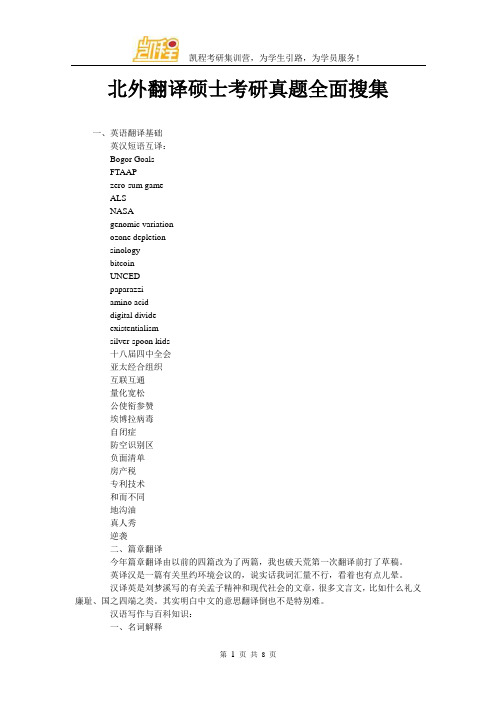
北外翻译硕士考研真题全面搜集一、英语翻译基础英汉短语互译:Bogor GoalsFTAAPzero-sum gameALSNASAgenomic variationozone depletionsinologybitcoinUNCEDpaparazziamino aciddigital divideexistentialismsilver-spoon kids十八届四中全会亚太经合组织互联互通量化宽松公使衔参赞埃博拉病毒自闭症防空识别区负面清单房产税专利技术和而不同地沟油真人秀逆袭二、篇章翻译今年篇章翻译由以前的四篇改为了两篇,我也破天荒第一次翻译前打了草稿。
英译汉是一篇有关里约环境会议的,说实话我词汇量不行,看着也有点儿晕。
汉译英是刘梦溪写的有关孟子精神和现代社会的文章,很多文言文,比如什么礼义廉耻、国之四端之类。
其实明白中文的意思翻译倒也不是特别难。
汉语写作与百科知识:一、名词解释尼罗河战略伙伴关系四大菩萨十字军中亚五国日心说元素周期律丝绸之路经济带金字塔APEC金砖四国九大行星三省六部的“六部”《牡丹亭》东盟IS(就是伊斯兰国)南北战争二十八宿《俄狄浦斯王》三一律“新寓言”派《菊与刀》北约苏辛《说文解字》二、应用文写作应用文是根据自己经历的某件事写一则消息,是新闻体裁的一种三、大作文大作文给一段材料,写一个人从火车上丢了一个鞋子,然后马上扔了另一个,说这只鞋留着也没用,有人捡到没准还能穿。
然后以“让失去变的可爱”为题写一篇作文。
本文系统介绍北外翻译硕士考研难度,北外翻译硕士就业,北外翻译硕士考研辅导,北外翻译硕士考研参考书,北外翻译硕士专业课五大方面的问题,凯程北外翻译硕士老师给大家详细讲解。
特别申明,以下信息绝对准确,凯程就是王牌的北外翻译硕士考研机构!五、北外翻译硕士考研初试参考书是什么北外翻译硕士参考书很多人都不清楚,这里凯程北外翻译硕士王牌老师给大家整理出来了,以供参考:英语方向:1、Bassnett,Susan.《翻译研究》Translation Studies,外教社,2004.2、Gentzler,Edwin.《当代翻译理论(第二版修订本)》Contemporary Translation Theories,外教社,2004.3、马会娟、苗菊编.《当代西方翻译理论选读》,外语教学与研究出版社,2009年。
北京外国语大学(357)英语翻译基础2018年真题
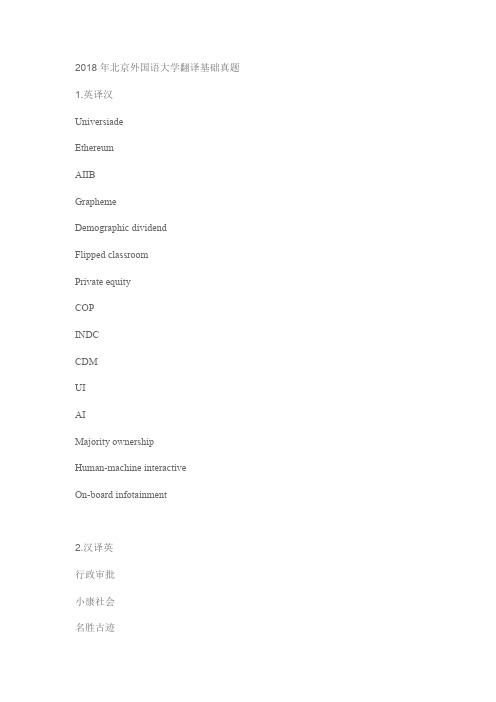
步入北京园的第一进院,是个四合院式的宫廷园林,依景种植松石、翠竹,还有 以白色花卉为主的牡丹、玉兰、海棠,体现了幽静、典雅的宫廷氛围;第二进院 是自然与人工交汇的山水园,突显堂皇大气,是全园景观的经典;第三进院则是 一处既含蓄又内敛的皇家山地园,北京园的主要建筑万象昭辉就坐落于此。
万象昭辉是北京园的最高点,拾阶而上,登上高处,园内的方池、书楼、廊榭、 亭台、石桥,尽收眼底;放眼园外,可看见京石铁路上的高铁列车飞驰而过,仿 佛预示着繁荣的过去与快速发展的今天。
2018 年北京外国语大学翻译基础真题 1.英译汉 Universiade Ethereum AIIB Grapheme Demographic dividend Flipped classroom Private equity COP INDC CDM UIБайду номын сангаасAI Majority ownership Human-machine interactive On-board infotainment
There were competing narratives on whether agriculture was becoming more desirable to young people as a result. Participants felt that these developments were making agriculture more and more profitable and therefore more appealing. But they felt that there was a huge obstacle in engaging in it —scarcity of land. Although the dominant view was that young people are disinterested in agriculture, some participants pointed out that this was not always the case.
上外考研2018英语翻译基础(真题)(回忆版)

上外考研2018高翻英语翻译基础(真题)(回忆版)一、汉译英,翻译划线部分,70分对中国90后,00后深入骨髓的剖析现如今的家庭教育之难,难在什么地方?难在我们的教育有太多的悖论和问题需要面对。
各位父母,我先问你们一个问题,你了解现在的孩子吗?我在这个问题上很有发言权,因为近20年来,我大概接触了8000个家庭案例。
当今的孩子是怎么回事?当今的孩子是什么人?我们要从本质上来把握。
假如我们不能从本质上来把握,学校教育也好,家庭教育也好,都不会在点子上。
从1993年以后孩子们就开始不一样了。
为什么这么说呢?理由是1993年中国取缔了粮票,这件事情年纪大的是不是还记得?在中国这样一个国家里面,取缔了粮票意味着什么?我们吃饭不愁了。
当一个民族吃饭不愁,尤其是到我们这样的民族吃饭不愁的时候,我们会愁什么呢?我们的需要开始变得不一样了,人对人的需要不一样了,家长对孩子的需要不一样了,社会对人的需要不一样,人对社会的需要不一样了。
我们来看1993年以后的人的基本特征,首先,他们都是独套公寓里的独子。
独套公寓里的独子有什么样的人生感受呢?你可以去试试,到春天的时候,买一只刚刚生出来的小鸡,养着它,给它好吃好喝,你看看是不是两个礼拜以后小鸡就死掉了,因为小鸡也会孤独。
现在的孩子带着天生的孤独感来到这个世界。
那么孤独会有哪些麻烦?一,人一孤独,无端伤感,莫名其妙流眼泪;二,人一孤独,思考力就变得非常强,所以麻烦就来了,既不思考吃,又不思考穿,他就过早地思考了一个终极问题,最高哲学问题,“我存在有什么意义?”我们现在的孩子,连四岁的孩子就会在那里发呆了,你不知道他小脑袋里想什么。
一旦人有这种问题,痛苦就伴随着他了。
所以我们教育面对的问题是我们得知道自己的子女是什么人,才可以有方向。
第一,当今的孩子背负着沉重的情感负担回想我们小时候,大部分人都生活在多子女家庭,父母很难投入过多的关注在某一个孩子身上。
但是现在的孩子是什么样?上海这样的城市里,一个孩子来到这个世界上,就有六个人围着他,这六个人会把最好的付出给他。
北外英语翻译资格证书考试试题
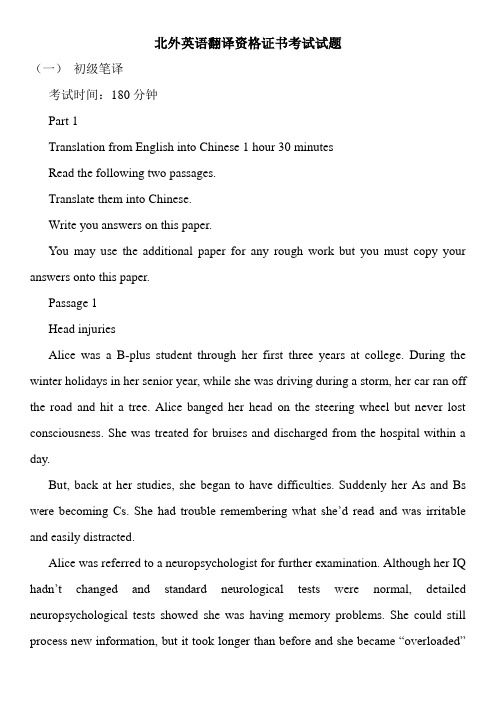
北外英语翻译资格证书考试试题(一)初级笔译考试时间:180分钟Part 1Translation from English into Chinese 1 hour 30 minutesRead the following two passages.Translate them into Chinese.Write you answers on this paper.You may use the additional paper for any rough work but you must copy your answers onto this paper.Passage 1Head injuriesAlice was a B-plus student through her first three years at college. During the winter holidays in her senior year, while she was driving during a storm, her car ran off the road and hit a tree. Alice banged her head on the steering wheel but never lost consciousness. She was treated for bruises and discharged from the hospital within a day.But, back at her studies, she began to have difficulties. Suddenly her As and Bs were becoming Cs. She had trouble remembering what she’d read and was irritable and easily distracted.Alice was referred to a neuropsychologist for further examination. Although her IQ hadn’t changed and standard neurological tests w ere normal, detailed neuropsychological tests showed she was having memory problems. She could still process new information, but it took longer than before and she became “overloaded”if she tried to do too much at once.Head injuries are often fatal, or of sufficient severity to require the hospitalization of victims. But there is a large group of people who sustain head injuries which can go undetected through ordinary medical examination. These are the people who seemingly recover from their injuries but still suffer subtle intellectual and behavioural effects that may seriously impair their ability to work and interact normally with other people. They are the victims of what experts call a “silent epidemic”. Some never lost consciousness and others never even suffered a direct blow to the head, yet brain damage occurred.Passage 2My fight against junk e-mailFiltering junk e-mail can be a tricky game of cat and mouse, as I learned when I set out to purge my In Box.I received an e-ma il the other day that gave me a moment’s pause. “Hey cutie, how are you??” It began. “I’m so sorry about last night, click here for a SUPRIXE to make you feel better.” I was suspicious for three reasons: my girlfriend never misspells like that, we had not had a row the previous night, and I was pretty sure she had not suddenly acquired an Australian e-mail address. At least one part of the message was accurate: if she ever pointed me to a website as sexy as that one, I’d be very surprised indeed.The cutie incident represented a setback in my war against junk e-mail. I used to get hundreds of these things a day, and some months ago, I vowed to rid my In Box permanently of every last one. What I soon learned was that most e-mail software can’t eradicate t he junk without throwing babies with the bath water.Microsoft outlook, for example, can trash any mail not sent directly to your address. But that ends up junking a lot of useful stuff such as discussions on my journalism, school alumni e-mail list. AOL can turn away mail from anyone not flagged as a friend, but part of my job is to accept correspondence from strangers-like you, dear reader.Part 2Translation from Chinese into English 1 hour 30 minutesRead the following two passages.Translate them into Chinese.Write you answers on this paper.You may use the additional paper for any rough work but you must copy your answers onto this paper.Passage 1我为乘客服务有一次,在拥挤的车厢门口,我听见一位男乘客客客气气地问他前面的一个女乘客:”您下车吗?”女乘客没理他。
北外英语翻译资格中级笔译试题
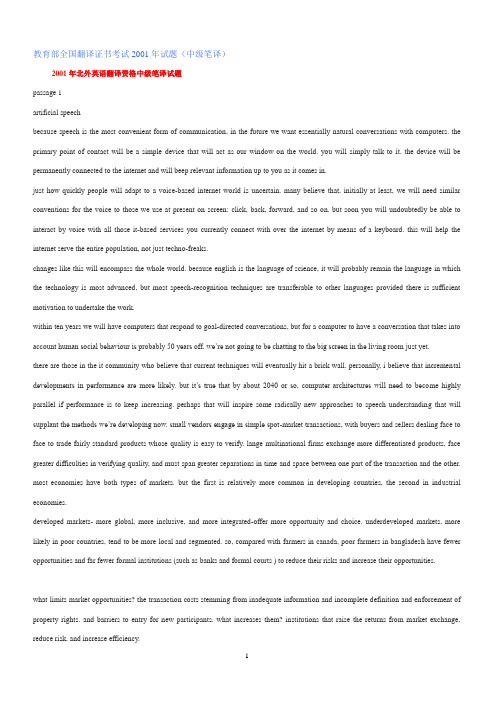
教育部全国翻译证书考试2001年试题(中级笔译)2001年北外英语翻译资格中级笔译试题passage 1artificial speechbecause speech is the most convenient form of communication, in the future we want essentially natural conversations with computers. the primary point of contact will be a simple device that will act as our window on the world. you will simply talk to it. the device will be permanently connected to the internet and will beep relevant information up to you as it comes in.just how quickly people will adapt to a voice-based internet world is uncertain. many believe that, initially at least, we will need similar conventions for the voice to those we use at present on screen: click, back, forward, and so on. but soon you will undoubtedly be able to interact by voice with all those it-based services you currently connect with over the internet by means of a keyboard. this will help the internet serve the entire population, not just techno-freaks.changes like this will encompass the whole world. because english is the language of science, it will probably remain the language in which the technology is most advanced, but most speech-recognition techniques are transferable to other languages provided there is sufficient motivation to undertake the work.within ten years we will have computers that respond to goal-directed conversations, but for a computer to have a conversation that takes into account human social behaviour is probably 50 years off. we’re not going to be chatting to the big screen in the living room just yet.there are those in the it community who believe that current techniques will eventually hit a brick wall. personally, i believe that incremental developments in performance are more likely. but it’s true that by about 2040 or so, computer architectures will need to beco me highly parallel if performance is to keep increasing. perhaps that will inspire some radically new approaches to speech understanding that will supplant the methods we’re developing now. small vendors engage in simple spot-market transactions, with buyers and sellers dealing face to face to trade fairly standard products whose quality is easy to verify. lange multinational firms exchange more differentiated products, face greater difficulties in verifying quality, and must span greater separations in time and space between one part of the transaction and the other. most economies have both types of markets. but the first is relatively more common in developing countries, the second in industrial economies.developed markets- more global, more inclusive, and more integrated-offer more opportunity and choice. underdeveloped markets, more likely in poor countries, tend to be more local and segmented. so, compared with farmers in canada, poor farmers in bangladesh have fewer opportunities and far fewer formal institutions (such as banks and formal courts ) to reduce their risks and increase their opportunities.what limits market opportunities? the transaction costs stemming from inadequate information and incomplete definition and enforcement of property rights. and barriers to entry for new participants. what increases them? institutions that raise the returns from market exchange, reduce risk, and increase efficiency.yet not all institutions promote inclusive markets. institutional designs that evolve through historical circumstances or are directed by policy makers are not necessarily the best for all of society or for economic growth and poverty reduction. for instance, state agricultural marketing boards, instead of helping farmers, have often resulted in lower incomes for them in africa. and institutions that once supported market transactions can outlive their usefulness, for example, privatization agencies and bank restructuring agencies. the challenge for policymakers is to shape institutional development in ways that enhance economic developmentPart 2 Translation from Chinese into English 2 hoursPassage 1保姆校长常常听到一些大学校长说:“我把学生当自己的儿女看待。
英语专业基础英语(翻译)历年真题试卷汇编10.doc

英语专业基础英语(翻译)历年真题试卷汇编10(总分:40.00,做题时间:90分钟)一、1 翻译(总题数:20,分数:40.00)1.将下列短文译成英语。
(北京外国语大学2009研,考试科目:英汉互译) 2008年11月9日,中国政府出台了进一步扩大内需、促进经济增长的十项措施,预计在未来两年时间内投资4万亿人民币。
中国政府在例行的中央经济工作会议召开之前突然宣布该方案,既显示了中国政府抗击金融危机、防范经济增长下滑的信心,也反映了中国政府对国内经济增长前景的预期明显恶化。
该方案刚一出台便引发世界范围内高度关注,并直接推动全球股市上涨。
然而,由于中国政府并未在第一时间详细披露该方案实施细则,近日来围绕该方案的猜测与争议绵延不绝。
(分数:2.00)填空项1:__________________2.将下列短文译为英语。
(北京外国语大学2008研,考试科目:英汉互译) 无论如何,创造财富的物质资源,不论其初始分配如何,最终是要通过各种各样的渠道,流入到具有企业家精神的人手里,这是自由市场的一个基本趋势。
这些人获得对他人的财富的支配权、使用权,以之为自己创造财富,并积累财富。
这正是自由市场具有效率的根源。
它可以动态地、自发地把资源从资源利用效率较低的人手里转移到资源利用效率较高的人手里。
中国人讲“富不过三代”,其中有一些无奈,但也揭示了自由市场的精髓所在:财富本身并不能充当财富的保障。
因为,财富本来就不是财富创造出来的。
所以,由于企业家精神积累了财富的人的后代,未必总是能够最有效地利用他们手里所掌握的资源。
如果是在身份制社会,这就将损害全社会的资源利用效率。
而自由市场向这些家庭提供了足够的制度安排,使之自然地将其掌握的资源交给富有企业家精神的人控制。
假如他们不愿意这样做,那市场就会无情地淘汰他们,以破产倒闭的方式使其交出对资源的控制权。
市场总是顽固地要把资源转移到能力最高的企业家手里。
权力控制经济的社会、身份制社会、国有企业制度,都无法做到这一点,因而其经济整体效率必然要比市场配置资源的社会低很多。
北外基础英语,同声传译试卷(历年题,转发)自己动手下载!98-04年的

1998年基础英语试卷Read the following passage:ARCHIBALD MACLEISH: Bicentennial of What?An address at the Bicentennial commemoration of the American Philosophical Society in PhiladelphiaIt is a common human practice to answer questions without truly asking them and the American bicentennial is merely the latest instance. Everyone knows what the Bicentennial celebrates: the 200th anniversary of the adoption, by the Continental Congress, of the Declaration of Independence. But no one asks what the Bicentennial is because no one asks what the Declaration was. The instrument of announcing American independence from Great Britain? Clearly that: but is that all it was? Is it only American independenc e from Great Britain we are celebrating on July 4, 1976——only the instrument which declared our independence? There have been other declarations of unilateral independence from Great Britain which no one is likely to remember for 200 years, much less to cel ebrate. “All men” ar e said in that document to be created equal and to have been endowed with certain unalienable rights. All governments are alleged to have been instituted among men to secure those rights ——to protect them. Are these, then, American rights? Doubtless——but only American? Is it the British Government which is declared to have violated them? Unquestionably——but the British Government alone? And the revolution against tyranny and arrogance which is here implied ——is it a revolution which American independence from the mediocre majesty of George III will win or is there something more intended? —— something for all mankind? ——for all the world?In the old days when college undergraduates still read history, any undergraduate could have told you that these are not rhetorical questions: that they were, from the beginning, two opinions about the Declaration and that they were held by (among others) the two great men who had most to do with its composition and its adoption by the Congress.John Adams, who supported the Declaration with all his formidable powers, inclined to the view that it was just what is called itself: a declaration of American independence. Thomas Jefferson, who wrote it, held the opposite opinion: it was a revolutionary p roclamation applicable to all mankind.“May it be the world”, he wrote to the citizens of Washington a few days before he died, “what I believe it will be: to some parts sooner, to others later, but finally to all, the signal of arousing men t o burst the chains…”And he went on in reverberating words: “The mass of mankind has not been born with saddles on their backs for a favored few, booted and spurred, ready to ride them by the grace of God.”Moreover, these two great and famous men were not the only Presidents of the Republic to choose between the alternatives: A third, as great as either, speaking in Philadelphia at the darkest moment in our history —— bearing indeed the whole weight of that history on his shoulders as he spoke —— turned to the Declaration for guidance for himself and for his country and made his choice between the meanings.Mr. Lincoln had been making his way slowly eastward in February 1861 from Springfield to Washington to take the oat h of office as President of a divided people on the verge of Civil War. He had reached Philadelphia on the 21st of February where he had been told of the conspiracy to murder him in Baltimore as he passed through that city. He had gone to Independence Hall before daylight on the 22nd. He had found a crowd waiting. He had spoken to them.He had often asked himself. Mr. Lincoln said, what great principle or idea it was which had held the Union so long together. “It was not,” he said, as though re plying directly to John Adams, “the mere matter of the separation from the mother country.”It was something more. “Something in the Declaration,” they heard him say. “Something giving liberty not alone to the people of this country but hope t o the world.” “It was that which gave promise that in due time the weights should be lifted from the shoulders of all men.”Anyone else, any modern President certainly, would have said, as most of them regularly do, that his hope for the count ry was fixed in huge expenditures for arms, in the possession of overwhelming power. Not Mr. Lincoln. Not Mr. Lincoln even at that desperate moment. His hope was fixed in a great affirmation of belief made almost a century before. It was fixed in the commi tment of the American people, at the beginning of their history as a people, to “ a great principle or idea”: the principle or idea of human liberty —— of human liberty not for themselves alone but for mankind.It was a daring gamble of Mr. Lin coln‟s ——but so too was Mr. Jefferson‟s Declaration ——so was the cause which Mr. Jefferson‟sDeclaration had defined. Could a nation be founded on the belief in liberty? Could belief in liberty preserve it? Two America n generations argued that issue but not ours —— not the generation of the celebrants of the 200th anniversary of that great event. We assume, I suppose, that Mr. Jefferson‟s policy was right for him and right for Mr. Lincoln, because it was successful. But whatever we think about Mr. Lincoln‟ view of the Declaration, whatever we believe about the Declaration in the past, in other men‟s lives, in other men‟s wars, we do not ask ourselves, as we celebrate its Bicentennial, what it is today, what it is to us.Our present President has never intimated by so much as a word that such a question might be relevant —— that it even exists. The Congress has not debated it. The state and Federal commissions charged with Bicentennial responsibility express no opinions. Only the generation of the young, so far as I am informed, has even mentioned it, and the present generation of the young has certain understanble prejudices, inherited from the disillusionments of recent years, which color their comments…Express your view that the nation brought into being by hat great document was, and had no choice but be, a revolutionary nation, and you will be reminded that, but for the accidental discovery of a piece of tape on a door latch, the President of the United States in the Bicentennial year would have been Richard Nixon. And so it will go until you are told at last that the American Revolution is a figure o f obsolescent speech; that the Declaration has become a museum exhibit in the National Archives; and that, as for the Bicentenn ial, it is a year-long commercial which ought to be turned off.Well, the indignation of the young is always admirable regardless of its verbal excesses —— far more admirable, certainly, than the indifference of the elders. But, unfortunately, it is the indifference of the elders we have to consider. And not only because it is a puzzling, a paradoxical, indifference but because it is as disturbing as it is paradoxical.Does our indifference to the explicitly revolutionary purpose of the Declaration -our silence about Mr. Jefferson‟s interpretation of that purpose —— mean that we no longer believe in that purpose —— no longer believe in human liberty? Hardly?...But if this is so, if we still believe in the cause of human liberty, why do we celebrate the anniversary of the document which defined it for us without a thought for the meaning of the definition, then or now? Why have we not heard from our representatives and our o fficials on his great theme?Is it because, although the Republic continues to believe in human liberty for itself, it no longer hopes for it in the world? Because it no longer thinks such a hope “realistic”?...So far, indeed, is Mr. Jefferson‟s revolution from being obsolete that it is now the only truly revolutionary force in the age we live in. And not despite the police states but because of them.In 1945, when e had driven the Nazis out of Europe and the Japanese out of the Pacific in the name of human freedom and human decency, we stood at the peak, not only of our power as a nation but of our greatness as a people. We were more nearly ourselves, our true selves as the inheritors of Thomas Jefferson and Abraham Lincoln, than we had ever been before. And yet within a few yea rs of that tremendous triumph, of the unexampled generosity of our nuclear offer to the world, of the magnificence of the marshall Plan, we were lost in the hysterical fears and ignoble deceits of Joe McCarthy and his followers and had adopted, as our foreign policy, the notion that if we “contained” the Russian initiative, we would some how or other be better off ourselves than if we pursued our historic pur pose as Jefferson conceived it.The result, as we now know, was disaster. And not only in Southeast Asia and Portugal and Africa but throughout the world, Containment put us in bed with every anti-Communist we could find including some of the most offensive despots then in business. It produced flagrantly subversive and shameful plots by American agencies against the duly elected governments of other countries. And it ended by persuading the new countries of the postwar world, the emerging nations, that he United States was to them and to their hopes what the Holy Alliance had been to us and ours 200 years before.I. Explain the following in your own words:1. All governments are alleged to have been instituted among men to secure those rights -to protect them.2. In the old days when college undergraduates still read history… (1) What is the implication of this statement? (2) How do you know?3. … who had most to do with its composition and its adoption by the Congress.4. May it be to the world, what I believe it will be: to some parts sooner, to o thers later, but finally to all, the signal of arousing men to burst the chains…5. The mass of mankind has not been born with saddles… by the grace of God.6. It was that which gave promise… from the shoulders of all men.7. It wasa daring gamble… which Mr. Jefferson‟s Declaration had defined. (1) What does “daring gamble” refer to? (2) What was the cause the Declaration had defined? 8. Our present president … that it even exists. 9. … you will be reminded… wo uld have been Richard Nixon. 10. … regardless of its verbal excesses 11. So far is Mr. Jefferson‟s revolution from being obsolete… but because of them. 12. And it ended by persuading… to us and ours 200 years before.II. What is the message the speaker wants to put across? III. Translate the following passage into English:“主人翁意识”,在我看来,也就是“所有者的意识”。
2018考研英语(一)真题及参考答案(完整版)
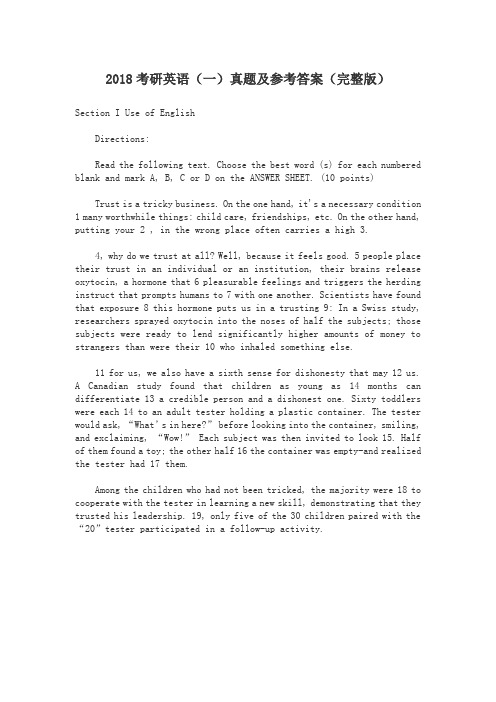
2018考研英语(一)真题及参考答案(完整版)Section I Use of EnglishDirections:Read the following text. Choose the best word (s) for each numbered blank and mark A, B, C or D on the ANSWER SHEET. (10 points)Trust is a tricky business. On the one hand, it's a necessary condition 1 many worthwhile things: child care, friendships, etc. On the other hand, putting your 2 , in the wrong place often carries a high 3.4, why do we trust at all? Well, because it feels good. 5 people place their trust in an individual or an institution, their brains release oxytocin, a hormone that 6 pleasurable feelings and triggers the herding instruct that prompts humans to 7 with one another. Scientists have found that exposure 8 this hormone puts us in a trusting 9: In a Swiss study, researchers sprayed oxytocin into the noses of half the subjects; those subjects were ready to lend significantly higher amounts of money to strangers than were their 10 who inhaled something else.11 for us, we also have a sixth sense for dishonesty that may 12 us.A Canadian study found that children as young as 14 months can differentiate 13 a credible person and a dishonest one. Sixty toddlers were each 14 to an adult tester holding a plastic container. The tester would ask, “What’s in here?” before looking into the container, smiling, and exclaiming, “Wow!” Each subject was then invited to look 15. Half of them found a toy; the other half 16 the container was empty-and realized the tester had 17 them.Among the children who had not been tricked, the majority were 18 to cooperate with the tester in learning a new skill, demonstrating that they trusted his leadership. 19, only five of the 30 children paired with the “20”tester participated in a follow-up activity.Section II Reading ComprehensionPart ADirections:Read the following four texts. Answer the questions below each text by choosing A, B, C or D. Mark your answers on the ANSWER SHEET. (40 points)Text 1Among the annoying challenges facing the middle class is one that will probably go unmentioned in the next presidential campaign: What happens when the robots come for their jobs?Don't dismiss that possibility entirely. About half of U.S. jobs are at high risk of being automated, according to a University of Oxford study, with the middle class disproportionately squeezed. Lower-income jobs like gardening or day care don't appeal to robots. But many middle-class occupations-trucking, financial advice, software engineering — have aroused their interest, or soon will. The rich own the robots, so they will be fine.This isn't to be alarmist. Optimists point out that technological upheaval has benefited workers in the past. The Industrial Revolution didn't go so well for Luddites whose jobs were displaced by mechanized looms, but it eventually raised living standards and created more jobs than it destroyed. Likewise, automation should eventually boost productivity, stimulate demand by driving down prices, and free workers from hard, boring work. But in the medium term, middle-class workers may need a lot of help adjusting.The first step, as Erik Brynjolfsson and Andrew McAfee argue in The Second Machine Age, should be rethinking education and job training. Curriculums —from grammar school to college- should evolve to focus less on memorizing facts and more on creativity and complex communication. Vocational schools should do a better job of fostering problem-solving skills and helping students work alongside robots. Online education can supplement the traditional kind. It could make extra training and instruction affordable. Professionals trying to acquire new skills will be able to do so without going into debt.The challenge of coping with automation underlines the need for the U.S. to revive its fading business dynamism: Starting new companies must be made easier. In previous eras of drastic technological change, entrepreneurs smoothed the transition by dreaming up ways to combine labor and machines. The best uses of 3D printers and virtual reality haven't been invented yet. The U.S. needs the new companies that will invent them.Finally, because automation threatens to widen the gap between capital income and labor income, taxes and the safety net will have to be rethought. Taxes on low-wage labor need to be cut, and wage subsidies such as the earned income tax credit should be expanded: This would boost incomes, encourage work, reward companies for job creation, and reduce inequality.Technology will improve society in ways big and small over the next few years, yet this will be little comfort to those who find their lives and careers upended by automation.Destroying the machines that are coming for our jobs would be nuts. But policies to help workers adapt will be indispensable.Text 2A new survey by Harvard University finds more than two-thirds of young Americans disapprove of President Trump’s use of Twitter. The implication is that Millennials prefer news from the White House to be filtered through other source, Not a president’s social media platform.Most Americans rely on social media to check daily headlines. Yet as distrust has risen toward all media, people may be starting to beef up their media literacy skills. Such a trend is badly needed. During the 2016 presidential campaign, nearly a quarter of web content shared by Twitter users in the politically critical state of Michigan was fake news, according to the University of Oxford. And a survey conducted for BuzzFeed News found 44 percent of Facebook users rarely or never trust news from the media giant.Young people who are digital natives are indeed becoming more skillfulat separating fact from fiction in cyberspace. A Knight Foundation focus-group survey of young people between ages 14and24 found they use “distributed trust” to verify stories. They cross-check sources and prefer news from different perspectives—especially those that are open about any bias. “Many young people assume a great deal of personal responsibility for educating themselves and actively seeking out opposing viewpoints,” the survey concluded.Such active research can have another effect. A 2014 survey conducted in Australia, Britain, and the United States by the University of Wisconsin-Madison found that young people’s reliance on social media led to greater political engagement.Social media allows users to experience news events more intimately and immediately while also permitting them to re-share news as a projection of their values and interests. This forces users to be more conscious of their role in passing along information. A survey by Barna research group found the top reason given by Americans for the fake news phenomenon is “reader error,” more so than made-up stories or factual mistakes in reporting. About a third say the problem of fake news lies in “misinterpretation or exaggeration of actual news” via social media. In other words, the choice to share news on social media may be the heart of the issue. “This indicates there is a real personal responsibility in counteracting this problem,” says Roxanne Stone, editor in chief at Barna Group.So when young people are critical of an over-tweeting president, they reveal a mental discipline in thinking skills – and in their choices on when to share on social media.Text 3Any fair-minded assessment of the dangers of the deal between Britain's National Health Service (NHS) and DeepMind must start by acknowledging that both sides mean well. DeepMind is one of the leading artificial intelligence (AI) companies in the world. The potential of this work applied to healthcare is very great, but it could also lead to further concentration of power in the tech giants. It Is against that background that the information commissioner, Elizabeth Denham, has issued her damning verdict against the Royal Free hospital trust under the NHS, which handed over to DeepMind the records of 1.6 million patients In 2015 on the basis of a vague agreement which took far too little account of the patients' rights and their expectations of privacy.DeepMind has almost apologized. The NHS trust has mended its ways. Further arrangements- and there may be many-between the NHS and DeepMindwill be carefully scrutinised to ensure that all necessary permissions have been asked of patients and all unnecessary data has been cleaned. There are lessons about informed patient consent to learn. But privacy is not the only angle in this case and not even the most important. Ms Denham chose to concentrate the blame on the NHS trust, since under existing law it “controlled” the data and DeepMind merely “processed" it. But this distinction misses the point that it is processing and aggregation, not the mere possession of bits, that gives the data value.The great question is who should benefit from the analysis of all the data that our lives now generate. Privacy law builds on the concept of damage to an individual from identifiable knowledge about them. That misses the way the surveillance economy works. The data of an individual there gains its value only when it is compared with the data of countless millions more.The use of privacy law to curb the tech giants in this instance feels slightly maladapted. This practice does not address the real worry. It is not enough to say that the algorithms DeepMind develops will benefit patients and save lives. What matters is that they will belong to a private monopoly which developed them using public resources. If software promises to save lives on the scale that dugs now can, big data may be expected to behave as a big pharm has done. We are still at the beginning of this revolution and small choices now may turn out to have gigantic consequences later. A long struggle will be needed to avoid a future of digital feudalism. Ms Denham's report is a welcome start.Text 4The U.S. Postal Service (USPS) continues to bleed red ink. It reported a net loss of $5.6 billion for fiscal 2016, the 10th straight year its expenses have exceeded revenue. Meanwhile, it has more than $120 billion in unfunded liabilities, mostly for employee health and retirement costs. There are many bankruptcies. Fundamentally, the USPS is in a historic squeeze between technological change that has permanently decreased demand for its bread-and-butter product, first-class mail, and a regulatory structure that denies management the flexibility to adjust its operations to the new realityAnd interest groups ranging from postal unions to greeting-card makers exert self-interested pressure on the USPS’s ultimate overseer-Congress-insisting that whatever else happens to the Postal Service, aspects of the status quo they depend on get protected. This is why repeated attempts at reform legislation have failed in recent years,leaving the Postal Service unable to pay its bills except by deferring vital modernization.Now comes word that everyone involved---Democrats, Republicans, the Postal Service, the unions and the system's heaviest users—has finally agreed on a plan to fix the system. Legislation is moving through the House that would save USPS an estimated $28.6 billion over five years, which could help pay for new vehicles, among other survival measures. Most of the money would come from a penny-per-letter permanent rate increase and from shifting postal retirees into Medicare. The latter step would largely offset the financial burden of annually pre-funding retiree health care, thus addressing a long-standing complaint by the USPS and its union.If it clears the House, this measure would still have to get through the Senate – where someone is bound to point out that it amounts to the bare, bare minimum necessary to keep the Postal Service afloat, not comprehensive reform. There’s no change to collective bargaining at the USPS, a major omission considering that personnel accounts for 80 percent of the agency’s costs. Also missing is any discussion of eliminating Saturday letter delivery. That common-sense change enjoys wide public support and would save the USPS $2 billion per year. But postal special-interest groups seem to have killed it, at least in the House. The emerging consensus around the bill is a sign that legislators are getting frightened about a politically embarrassing short-term collapse at the USPS. It is not, however, a sign that they’re getting serious about transforming the postal system for the 21st century.Part BDirections:The following paragraphs are given in a wrong order. For Questions 41-45, you are required to reorganize these paragraphs into a coherent article by choosing from the list A-G and filling them into the numbered boxes. Paragraphs C and F have been correctly placed. Mark your answers on ANSWER SHEET. (10 points)A. In December of 1869, Congress appointed a commission to select a site and prepare plans and cost estimates for a new State Department Building. The commission was also to consider possible arrangements for the War and Navy Departments. To the horror of some who expected a Greek Revival twin of the Treasury Building to be erected on the other side ofthe White House, the elaborate French Second Empire style design by Alfred Mullett was selected, and construction of a building to house all three departments began in June of 1871.B. Completed in 1875, the State Department's south wing was the first to be occupied, with its elegant four-story library (completed in 1876), Diplomatic Reception Room, and Secretary's office decorated with carved wood, Oriental rugs, and stenciled wall patterns. The Navy Department moved into the east wing in 1879, where elaborate wall and ceiling stenciling and marquetry floors decorated the office of the Secretary.C. The State, War, and Navy Building, as it was originally known, housed the three Executive Branch Departments most intimately associated with formulating and conducting the nation's foreign policy in the last quarter of the nineteenth century and the first quarter of the twentieth century-the period when the United States emerged as an international power. The building has housed some of the nation's most significant diplomats and politicians and has been the scene of many historic events.D. Many of the most celebrated national figures have participated in historical events that have taken place within the EEOB's granite walls. Theodore and Franklin D. Roosevelt, William Howard Taft, Dwight D. Eisenhower, Lyndon B. Johnson, Gerald Ford, and George H. W. Bush all had offices in this building before becoming president. It has housed 16 Secretaries of the Navy, 21 Secretaries of War, and 24 Secretaries of State. Winston Churchill once walked its corridors and Japanese emissaries met here with Secretary of State Cordell Hull after the bombing of Pearl Harbor.E. The Eisenhower Executive Office Building (EEOB) commands a unique position in both the national history and the architectural heritage of the United States. Designed by Supervising Architect of the Treasury, Alfred B. Mullett, it was built from 1871 to 1888 to house the growing staffs of the State, War, and Navy Departments, and is considered one of the best examples of French Second Empire architecture in the country.F. Construction took 17 years as the building slowly rose wing by wing. When the EEOB was finished, it was the largest office building in Washington, with nearly 2 miles of black and white tiled corridors. Almost all of the interior detail is of cast iron or plaster; the use of wood was minimized to insure fire safety. Eight monumental curving staircases of granite with over 4,000 individually cast bronze balusters are capped by four skylight domes and two stained glass rotundas.G. The history of the EEOB began long before its foundations were laid.The first executive offices were constructed between 1799 and 1820. A series of fires (including those set by the British in 1814) and overcrowded conditions led to the construction of the existing Treasury Building. In 1866, the construction of the North Wing of the Treasury Building necessitated the demolition of the State Department building.【答案】41. (E)→C →42. (G) →43. (A)→F→44. (B)→45. (D)Part CDirections:Read the following text carefully and then translate the underlined segments into Chinese. Your translation should be written neatly on the ANSWER SHEET. (10 points)Shakespeare’s life time was coincident with a period of extraordinary activity and achievement in the drama.(46) By the date of his birth Europe was witnessing the passing of the religious drama, and the creation of new forms under the incentive of classical tragedy and comedy. These new forms were at first mainly written by scholars and performed by amateurs, but in England, as everywhere else in western Europe, the growth of a class of professional actors was threatening to make the drama popular, whether it should be new or old, classical or medieval, literary or farcical. Court, school organizations of amateurs, and the traveling actors were all rivals in supplying a widespread desire for dramatic entertainment; and (47) no boy who went a grammar school could be ignorant that the drama was a form of literature which gave glory to Greece and Rome and might yet bring honor to England.When Shakespeare was twelve years old, the first public playhouse was built in London. For a time literature showed no interest in this public stage. Plays aiming at literary distinction were written for school or court, or for the choir boys of St. Paul’s and the royal chapel, who, however, gave plays in public as well as at court.(48) but the professional companies prospered in their permanent theaters, and university men with literature ambitions were quick to turn to these theaters as offering a means of livelihood. By the time Shakespeare was twenty-five, Lyly, Peele, and Greene had made comedies that were at once popular and literary; Kyd had written a tragedy that crowded the pit; and Marlowe had brought poetry and genius to triumph on the common stage - where they had played no part since the death of Euripides. (49) A native literary drama had been created, its alliance with the public playhouses established, and at least some of its great traditions had been begun.The development of the Elizabethan drama for the next twenty-five years is of exceptional interest to students of literary history, for in this brief period we may trace the beginning, growth, blossoming, and decay of many kinds of plays, and of many great careers. We are amazed today at the mere number of plays produced, as well as by the number of dramatists writing at the same time for this London of two hundred thousand inhabitants. (50)To realize how great was the dramatic activity, we must remember further that hosts of plays have been lost, and that probably there is no author of note whose entire work has survived.【参考译文】46.到莎士比亚出生的年代,欧洲经历了宗教戏剧的消亡,以及在古典悲剧和喜剧的影响下新的戏剧形式的产生。
2013年北京外国语大学英语翻译基础真题试卷(题后含答案及解析)
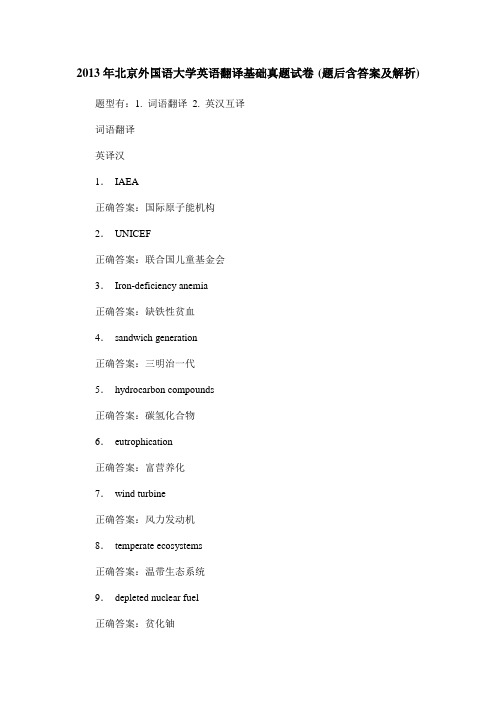
2013年北京外国语大学英语翻译基础真题试卷(题后含答案及解析) 题型有:1. 词语翻译 2. 英汉互译词语翻译英译汉1.IAEA正确答案:国际原子能机构2.UNICEF正确答案:联合国儿童基金会3.Iron-deficiency anemia正确答案:缺铁性贫血4.sandwich generation正确答案:三明治一代5.hydrocarbon compounds正确答案:碳氢化合物6.eutrophication正确答案:富营养化7.wind turbine正确答案:风力发动机8.temperate ecosystems正确答案:温带生态系统9.depleted nuclear fuel正确答案:贫化铀10.genome正确答案:基因组11.nanotechnology正确答案:纳米技术12.marginal cost正确答案:边际成本13.discount market正确答案:贴现市场14.LDC正确答案:欠发达国家15.eye candy正确答案:华而不实汉译英16.页岩气正确答案:shale gas17.居家养老正确答案:home—based care for the aged18.参政议政正确答案:participate in the administration and discussion of state affairs 19.本币互换协议正确答案:bilateral currency swap agreement20.自主知识产权正确答案:intellectual property right21.存款准备金正确答案:deposit reserve22.专属经济区正确答案:exclusive economic zone23.文化逆差正确答案:cultural deficit24.光伏电池正确答案:photovoltaic cell25.装机容量正确答案:installed capacity26.差额选举正确答案:competitive election27.医药分开正确答案:separation of clinic from pharmacy 28.官二代正确答案:the children of powerful officials 29.屌丝正确答案:diors30.打酱油正确答案:it’s none of someone’s business 英汉互译英译汉31.The conifer hedges in front of J. K. Rowling’s seventeenth-century house, in Edinburgh, are about twenty feet tall. They reach higher than the street lamps in front of them, and evoke the entrance to the spiteful maze in the film adaptation of “Harry Potter and the Goblet of Fire, “ the fourth volume of her fantasy series. Rowling, who at forty-seven, is about to publish her first novel for adults—it is set in a contemporary Britain familiar with Jay-Z and online pornography, but is shaded with memories of her own, quite cheerless upbringing—lives here with her second husband, Neil Murray, a doctor, and their children. She has a reputation for reserve: for being likable but shy and thin-skinned, and not at all comfortable with the personal impact of having created a modern myth, sold four hundred and fifty million books, and inspired more than six hundred thousand pieces of Harry Potter fan fiction, a total that increases by at least a thousand stories a week.正确答案:J.K.罗琳住在爱丁堡一座十七世纪的房子里,周围满是针叶树,差不多6.1米高,比它们前面的街灯还要高,很容易让人想起罗琳第四部小说《哈利·波特与火焰杯》的改编电影中神秘莫测的学校入口。
2018年考研北京大学计算机辅助翻译专业真题回忆

2篇英译汉,22篇汉译英,最后一个编译题(50分)。
英汉互译忘了具体多少了,大概55开。
英译汉第一个(20分):讲的是:地理环境对发音的影响。
不难,第二个(25分):特朗普拉拢选民的事情,具体没搞懂,瞎翻的(之前根本没准备过政治类的翻译,打脸了,,)汉译英是出的一篇文章,节选的句子和小段落的翻译。
汉译英第一个(25分):地理气候的寒冷或者干燥对居民发音的影响?记不清了,感觉跟英译汉第一个混了。
第二个(30分):最后写的这个题目。
将的是人工智能(机器翻译)对翻译行业的影响。
得出的结论是:机器翻译不会替代人工,但是会摧毁这个行业。
考的是这个专业,做到这样的题目。
感觉很讽刺。
最后一篇摘译题:讲述的是有关阿里巴巴的事情。
题目要求:不能顺序摘译原文,要命题,写作文,有自己的论点论据。
论据必须使用原文的内容。
字数400-600.多了或者少了都要扣分,,总共有3篇文章。
总的来说,题目不是很难,自己理一理思路,写出来一篇文章不是很难的。
第一篇:讲述的是阿里巴巴的在数据信息方面的优势。
既有淘宝天猫的海量用户数据,又有线下的商超和打车?的数据。
这让阿里很有竞争优势。
而且阿里的创新精神代表国家的创新驱动的战略,得到国家的支持。
海外国家的类似的公司却不能这样得到海量的私人数据信息,对阿里羡慕嫉妒恨。
第二篇:讲述的是印度电商PayTM的创始人XXX出生在一个距离新德里一百多公里的偏僻农村,上的大学是印度理工学院?,然后偶然间接触到马爸爸,然后自己思考可以借鉴阿里巴巴在中国的成功,吧这种模式搬到印度去。
结果拿到了阿里的投资,然后就不拉不拉,,,称为印度比较领先的电商公司。
后面没有资金了还是找的马爸爸来融资的,并表示,当今移动互联网的时代,不用像以往一样,看西方国家的先进之处,而是要看东方,看中国。
第三篇:讲述的是阿里投资东南亚某电商公司的情况。
阿里是其最大的股东。
并且增持了后者的股票。
从50+%增持到90+%。
该公司在东南亚市场很有竞争力,在投入运营的6个东南亚国家中,其中有5个国家都是最主要的竞争者。
上外2018年MTI真题回忆版

上外2018年MTI真题回忆版(超详细)(一)翻译硕士英语一、阅读,回答问题(哲学类,3页5面,四个问题,40分)标题:Barney's caseStudy of philosophy knowledgeBarney’s case of the study of history of philosophy?(Barney's case for the history of philosophy)……问题:1.What are the reasons Barney cite for the study of history by three goroups of people?2. According to the passage, what are Martin Lin's interpretation about philosphers?3.How does the author comment on the men's innate thirst for knowledge?4.Sum up how the author writes about Barney and Martin Lin’s discussion on philosophical progress二、Writing. 800words, 60分Digital Humanities in the New Era(二)英语翻译基础一、汉译英,翻译划线部分,70分对中国90后,00后深入骨髓的剖析现如今的家庭教育之难,难在什么地方?难在我们的教育有太多的悖论和问题需要面对。
各位父母,我先问你们一个问题,你了解现在的孩子吗?我在这个问题上很有发言权,因为近20年来,我大概接触了8000个家庭案例。
当今的孩子是怎么回事?当今的孩子是什么人?我们要从本质上来把握。
假如我们不能从本质上来把握,学校教育也好,家庭教育也好,都不会在点子上。
北外翻译基础真题
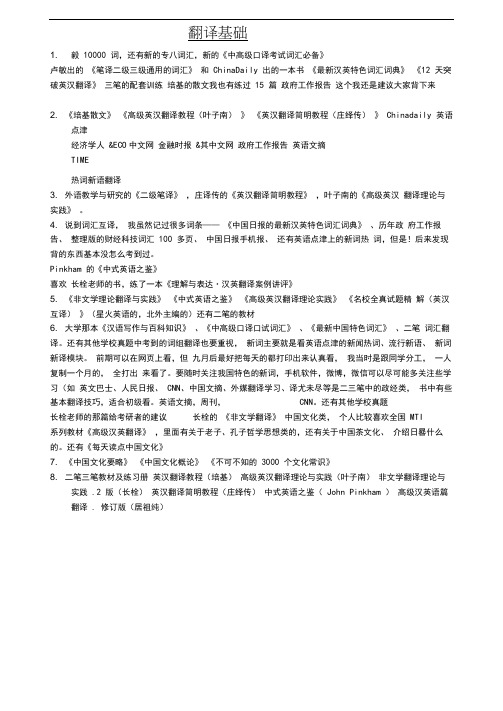
翻译基础1. 毅10000 词,还有新的专八词汇,新的《中高级口译考试词汇必备》卢敏出的《笔译二级三级通用的词汇》和ChinaDaily 出的一本书《最新汉英特色词汇词典》《12 天突破英汉翻译》三笔的配套训练培基的散文我也有练过15 篇政府工作报告这个我还是建议大家背下来2. 《培基散文》《高级英汉翻译教程(叶子南)》《英汉翻译简明教程(庄绎传)》Chinadaily 英语点津经济学人&ECO中文网金融时报&其中文网政府工作报告英语文摘TIME热词新语翻译3. 外语教学与研究的《二级笔译》,庄译传的《英汉翻译简明教程》,叶子南的《高级英汉翻译理论与实践》。
4. 说到词汇互译,我虽然记过很多词条——《中国日报的最新汉英特色词汇词典》、历年政府工作报告、整理版的财经科技词汇100 多页、中国日报手机报、还有英语点津上的新词热词,但是!后来发现背的东西基本没怎么考到过。
Pinkham 的《中式英语之鉴》喜欢长栓老师的书,练了一本《理解与表达·汉英翻译案例讲评》5. 《非文学理论翻译与实践》《中式英语之鉴》《高级英汉翻译理论实践》《名校全真试题精解(英汉互译)》(星火英语的,北外主编的)还有二笔的教材6. 大学那本《汉语写作与百科知识》、《中高级口译口试词汇》、《最新中国特色词汇》、二笔词汇翻译。
还有其他学校真题中考到的词组翻译也要重视,新词主要就是看英语点津的新闻热词、流行新语、新词新译模块。
前期可以在网页上看,但九月后最好把每天的都打印出来认真看,我当时是跟同学分工,一人复制一个月的,全打出来看了。
要随时关注我国特色的新词,手机软件,微博,微信可以尽可能多关注些学习(如英文巴士、人民日报、CNN、中国文摘、外媒翻译学习、译尤未尽等是二三笔中的政经类,书中有些基本翻译技巧,适合初级看。
英语文摘,周刊,CNN。
还有其他学校真题长栓老师的那篇给考研者的建议长栓的《非文学翻译》中国文化类,个人比较喜欢全国MTI系列教材《高级汉英翻译》,里面有关于老子、孔子哲学思想类的,还有关于中国茶文化、介绍日晷什么的。
2018年北京大学(北大)翻硕英语(英语笔译)考研真题及历年真题答案
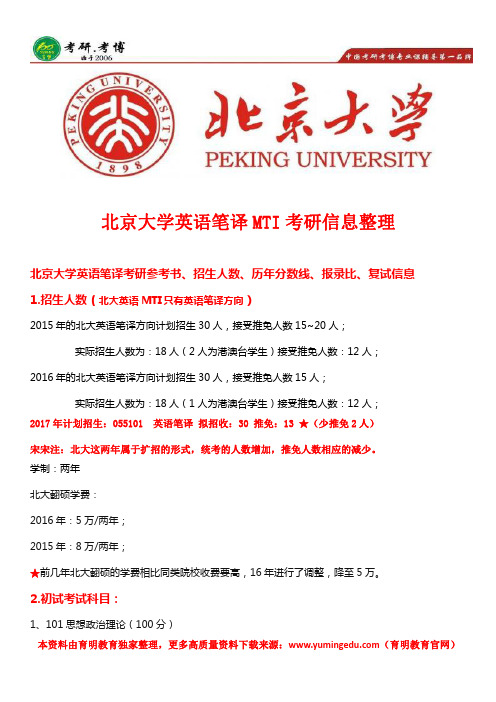
北京大学英语笔译MTI考研信息整理北京大学英语笔译考研参考书、招生人数、历年分数线、报录比、复试信息1.招生人数(北大英语MTI只有英语笔译方向)2015年的北大英语笔译方向计划招生30人,接受推免人数15~20人;实际招生人数为:18人(2人为港澳台学生)接受推免人数:12人;2016年的北大英语笔译方向计划招生30人,接受推免人数15人;实际招生人数为:18人(1人为港澳台学生)接受推免人数:12人;2017年计划招生:055101英语笔译拟招收:30推免:13★(少推免2人)宋宋注:北大这两年属于扩招的形式,统考的人数增加,推免人数相应的减少。
学制:两年北大翻硕学费:2016年:5万/两年;2015年:8万/两年;★前几年北大翻硕的学费相比同类院校收费要高,16年进行了调整,降至5万。
2.初试考试科目:1、101思想政治理论(100分)2、211翻译硕士英语(100分)3、357英语翻译基础(150分)4、448汉语写作与百科知识(150分)★★★育明宋老师解析:北大英语MTI只有笔译一个方向,初试除了思想政治理论是全国统一试卷,剩下的三门专业课,都是北大自主出题,出题的整体方向都偏文学性,特别指出的是,北大英语MTI 和日语的MTI的专业课汉语写作与百科知识,考的是同一张试卷,分为基础知识(100分)和专业知识(50分)两部分,满分150分.3.初试题型分析:一、初试题型1、翻译硕士英语:单选、阅读理解、写作(个别院校会有完型和改错);北大的题型会有一些不同,在原有的基础上加入了排序题,排序题相对来说会有一定的难度。
2、英语翻译基础:本考试包括二个部分:词语翻译和外汉互译,总分150分;词语翻译30分(英译汉、汉译英):15个外文术语及15个中文术语、缩略语或专有名词;段落翻译120分(英译汉、汉译英):两端段或是文章,250-350个单词或者150-250个汉字;3、汉语写作与百科知识:本考试包括二个部分:百科知识和汉语写作,总分150分;百科知识50分:名词解释或者是选择填空25个;汉语写作100分:可分为大作文和小作文的写作,大作文(60分)体裁可以是说明文、议论文或应用文;小作文(40分)的写作一般是通知类、说明类、倡议书、会议通知、商务信函等。
北外英语翻译资格中级笔译试题

教育部全国翻译证书考试2001年试题(中级笔译)2001年北外英语翻译资格中级笔译试题passage 1artificial speechbecause speech is the most convenient form of communication, in the future we want essentially natural conversations with computers. the primary point of contact will be a simple device that will act as our window on the world. you will simply talk to it. the device will be permanently connected to the internet and will beep relevant information up to you as it comes in.just how quickly people will adapt to a voice-based internet world is uncertain. many believe that, initially at least, we will need similar conventions for the voice to those we use at present on screen: click, back, forward, and so on. but soon you will undoubtedly be able to interact by voice with all those it-based services you currently connect with over the internet by means of a keyboard. this will help the internet serve the entire population, not just techno-freaks.changes like this will encompass the whole world. because english is the language of science, it will probably remain the language in which the technology is most advanced, but most speech-recognition techniques are transferable to other languages provided there is sufficient motivation to undertake the work.within ten years we will have computers that respond to goal-directed conversations, but for a computer to have a conversation that takes into account human social behaviour is probably 50 years off. we’re not going to be chatting to the big screen in the living room just yet.there are those in the it community who believe that current techniques will eventually hit a brick wall. personally, i believe that incremental developments in performance are more likely. but it’s true that by about 2040 or so, computer architectures will need to beco me highly parallel if performance is to keep increasing. perhaps that will inspire some radically new approaches to speech understanding that will supplant the methods we’re developing now. small vendors engage in simple spot-market transactions, with buyers and sellers dealing face to face to trade fairly standard products whose quality is easy to verify. lange multinational firms exchange more differentiated products, face greater difficulties in verifying quality, and must span greater separations in time and space between one part of the transaction and the other. most economies have both types of markets. but the first is relatively more common in developing countries, the second in industrial economies.developed markets- more global, more inclusive, and more integrated-offer more opportunity and choice. underdeveloped markets, more likely in poor countries, tend to be more local and segmented. so, compared with farmers in canada, poor farmers in bangladesh have fewer opportunities and far fewer formal institutions (such as banks and formal courts ) to reduce their risks and increase their opportunities.what limits market opportunities? the transaction costs stemming from inadequate information and incomplete definition and enforcement of property rights. and barriers to entry for new participants. what increases them? institutions that raise the returns from market exchange, reduce risk, and increase efficiency.yet not all institutions promote inclusive markets. institutional designs that evolve through historical circumstances or are directed by policy makers are not necessarily the best for all of society or for economic growth and poverty reduction. for instance, state agricultural marketing boards, instead of helping farmers, have often resulted in lower incomes for them in africa. and institutions that once supported market transactions can outlive their usefulness, for example, privatization agencies and bank restructuring agencies. the challenge for policymakers is to shape institutional development in ways that enhance economic developmentPart 2 Translation from Chinese into English 2 hoursPassage 1保姆校长常常听到一些大学校长说:“我把学生当自己的儿女看待。
2018年北语翻硕真题解析
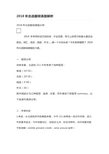
2018年北语翻硕真题解析2018年北语翻硕真题分析2018年考研初试已经结束,不论结果,学习上的努力和奋斗都没法抹去。
词汇,语法,阅读,作文......哪一个令你头疼?今天老师整理了2018年北语翻硕真题给大家。
一.题型分析总体来看,北语的211今年考察了四种题型:单选(10*10)完型(20*20)阅读(3*40)作文(30)其中阅读分为三种题型,选择,主观,另外增加了新题型summary,以下会进行具体分析。
二.考察内容1.单选:从北语的历年的真题来看,今年211的单选一改往年风格,前几年侧重考语法,今年侧重词汇,包括近义词,形近词辨析。
另外侧重对题干的理解(entitle present credit;arise arouse这种)2.完型:前十道是有选项完型,主要考语法,比如有选动词的进行时还是过去分词形式,还考察了介词;后十道是无选项完型,这就比较考察基础了,很多同学都在这一题空很多,词汇量任何时候都很重要。
3.阅读:俗话说,得阅读者得天下,这肯定是至理名言。
北语的阅读今年是有三道大题,而且增加了新题型:A、选择(5*10)关于转基因实验的一篇文章,大致内容是其可以拯救濒危物种,治疗疾病,但实验风险性不可控。
B、主观题阅读(3*15)3道主观题篇幅长度A4纸4面;主要讲了Modern existentialism现代存在主义的诞生。
三位年轻哲学家在巴黎一间小酒馆里的交谈,三位中有一对情侣在法国读书(一女B**一男S**),另一位在德国上学,给这对情侣介绍了新的哲学研究角度。
不同于以往探究抽象的理论,而是研究大家经历过的事情,探究所研究的对象是否真实存在是没有意义的,而是应该研究它为什么存在,且concentrate on who are they being and let them present themselves.?题目一简要概述the birth of modern existentialism题目二列举提到的(现象主义还是存在主义?)哲学家并概述他们的观点题目三文章最后提到B为了探索哲学买完书后迫不及待read it when walked across the street 与Kants encountered *someone的事例类比问为什么可以类比?C、Summary(新题型)no less than 100 words;Second major criticism of fantasy is childish……篇幅跟第二题差不多4、作文(no less than 300 words)关于professional translators misunderstand the source text.The cause and the effect给了一段材料让你概括misundersta三. 19年考生复习建议整体来看,今年的题很活,而且很考察英语基本功,尤其是对篇章的理解和概括能力。
2020年北京外国语大学研究生入学考试英语翻译基础真题
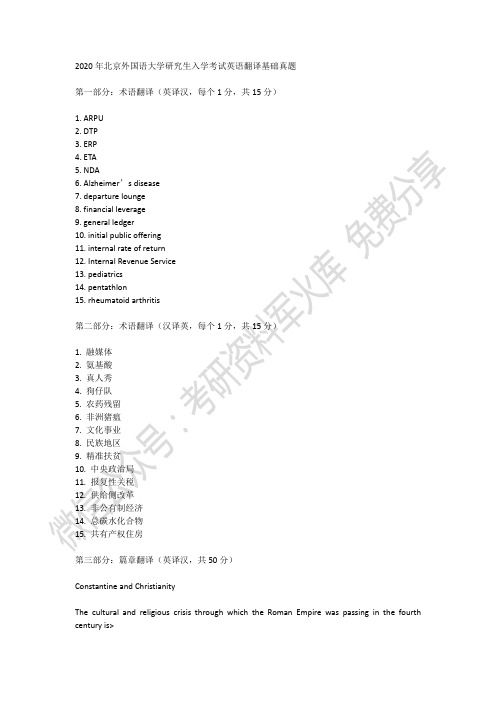
2020年北京外国语大学研究生入学考试英语翻译基础真题第一部分:术语翻译(英译汉,每个1分,共15分)1. ARPU2. DTP3. ERP4. ETA5. NDA6. Alzheimer’s disease7. departure lounge8. financial leverage9. general ledger10. initial public offering11. internal rate of return12. Internal Revenue Service13. pediatrics14. pentathlon15. rheumatoid arthritis第二部分:术语翻译(汉译英,每个1分,共15分)1. 融媒体2. 氨基酸3. 真人秀4. 狗仔队5. 农药残留6. 非洲猪瘟7. 文化事业8. 民族地区9. 精准扶贫10. 中央政治局11. 报复性关税12. 供给侧改革13. 非公有制经济14. 总碳水化合物15. 共有产权住房第三部分:篇章翻译(英译汉,共50分)Constantine and ChristianityThe cultural and religious crisis through which the Roman Empire was passing in the fourth century is>The person who was chiefly responsible for the many changes in the empire was Constantine the Great. During his reign, Christianity stepped for the first time>The conversion of nations or states to Christianity has usually taken place during the early stage of their historical existence when the past has created no firmly-established traditions, but merely some crude and primitive customs and forms of government. In such cases the conversion has caused no great crisis in the life of the people. But this was not characteristic of the Roman Empire in the fourth century. It already possessed an old world culture and had developed forms of government perfect for that time. It had a great past and an extensive body of ideas which had been assimilated by the population. This empire, changing in the fourth century into a Christian state, entered upon an era during which its past was contradicted, at times completely denied; this was bound to lead to an extremely acute and difficult crisis.第四部分:篇章翻译(汉译英,共70分)仁程颢伦理学的最重要特点强调“识仁”。
- 1、下载文档前请自行甄别文档内容的完整性,平台不提供额外的编辑、内容补充、找答案等附加服务。
- 2、"仅部分预览"的文档,不可在线预览部分如存在完整性等问题,可反馈申请退款(可完整预览的文档不适用该条件!)。
- 3、如文档侵犯您的权益,请联系客服反馈,我们会尽快为您处理(人工客服工作时间:9:00-18:30)。
今年翻译的词条有80%左右是凯程的辅导材料中讲过的,共享单车、表情包这些新潮词汇是老师们常常挂在嘴边让同学们熟记的;传统的词条如“民主集中制”、带有文化韵味的“论语”,都是最经典的。
翻译的篇章英译汉的行文风格,与《经济学人》等经典外刊的风格无差,是我们经常训练的内容。
汉译英涉及的是中国传统文化类内容,文章中有些名词专业化程度较高,但根据北外评分标准,有一些名词可以意译,可以给一定分数。
即便是同一个错误表达出现了多次,也只按错一个词计算,因此大家不必过于紧张。
静候同学们的佳音。
相信有不少同学期待相对完整的真题,下面凯程教育梳理的完整回忆版真题~~
词语翻译
英译汉
Universiade
Flipped classroom
Private equity
COP
INDC
CDM
UI
AI
Majority ownership
Human-machine interactive
Ethereum
汉译英
行政审批
名胜古迹
民主集中制
共享单车
植树造林
表情包
中央军委
食品添加剂
社会主义核心价值观
员工福利
论语
译制片
要有大局意识
篇章翻译
英译汉:有关埃塞俄比亚青年与农业
A survey of rural in- and out-of school young people towards agriculture, based on field-work in two regions in Ethiopia, is remarkably rich and insightful. Life as a farmer was tied to life in a village which most respondents saw as hard and demanding. Yet there was considerable heterogeneity in the views of the young. Participants in both regions concurred that agriculture has changed significantly over the last decade. The introduction and adoption of agricultural inputs such as improved seeds, fertilisers and better farming methods have produced significant increases in productivity and earnings.
There were competing narratives on whether agriculture was becoming more desirable to young people as a result. Participants felt that these developments were making agriculture more and more profitable and therefore more appealing. But they felt that there was a huge obstacle in engaging in it —scarcity of land. Although the dominant view was that young people are disinterested in agriculture, some participants pointed out that this was not always the case.
A slightly more positive attitude towards agriculture was evident among young people who had left school, either failing to complete high school for various reasons or to qualify for higher level education. Although this group of respondents were equally aware of the grimness of traditional agriculture and the life of the common farmer, many were not dismissive of agriculture as a possible future livelihood, while a few even saw it as a preferred livelihood option, under improved conditions.
凯程葛老师点评:本文为叙事性文章,行文风格与《经济学人》或FT比较类似。
文章整体难度不大,避免出现漏译或者句子不通顺的情况。
汉译英:园博园的北京园介绍
这个依山而建、占地1.3公顷的北京园,由三进庭院组成,融汇了皇家园林的精华,包括幽雅的宫廷园、富丽大气的山水园、含蓄内敛的山地园,处处彰显了皇家园林富丽典雅的气质。
步入北京园的第一进院,是个四合院式的宫廷园林,依景种植松石、翠竹,还有以白色花卉为主的牡丹、玉兰、海棠,体现了幽静、典雅的宫廷氛围;第二进院是自然与人工交汇的山水园,突显堂皇大气,是全园景观的经典;第三进院则是一处既含蓄又内敛的皇家山地园,北京园的主要建筑万象昭辉就坐落于此。
万象昭辉是北京园的最高点,拾阶而上,登上高处,园内的方池、书楼、廊榭、亭台、石桥,尽收眼底;放眼园外,可看见京石铁路上的高铁列车飞驰而过,仿佛预示着繁荣的过去与快速发展的今天。
凯程葛老师点评:这篇文章出现了很多与中国古典文化、建筑等等有关的词汇。
本文属于介绍类文本,同时有宣传功能。
中文版的景点介绍包含诸多形容词,让读者有种身临其境之感。
然而,英文的文本要较为忠实地反映译文的核心信息,部分原文内容可以在译文中简化或者省略不译。
